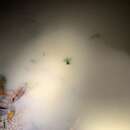en
names in breadcrumbs


IUCN Red List of Threatened Species: least concern
Development - Life Cycle: metamorphosis
Status Unknown
Status Unknown
The flying frog has a diet that consists of insects, and other small invertebrates (Wallace's 1999).
Malaysia and Borneo
Biogeographic Regions: oriental (Native )
Wallace's flying frog inhabits tropical moist forests.
Terrestrial Biomes: forest ; rainforest
Wallace's flying frog is a relatively small organism (15 - 20 mm) that possesses a distinct large eye. A tympanum membrane is located posterior to the eye. This anatomical feature serves as an eardrum to Rhacophorids as well as to other species of Anurans (Cogger and Zweifel, 1998). The color of the body is a shiny green with lighter yellow on the lateral sides as well as on the toe pads and snout. Wallace's flying frog is an arboreal amphibian that has a terminal segment of each finger and toe which is expanded into specialized toepads that allow these treefrogs to adhere to vertical surfaces. In addition to toepads flying frogs have huge, fully webbed hands and feet, also skin along the side of the body. These provide an increase in surface area so that when the limbs, fingers and toes are extended apart they allow the frogs to glide from high perches (Pakcenter 1999). The hindlimbs are relatively larger then the forelimbs and provide thrust upon jumping.
Other Physical Features: ectothermic ; bilateral symmetry
Before mating, the female produces a fluid that she beats into a foam with her hind legs. She then lays her eggs in this bubble nest, at the same time the male fertilizes the eggs with his sperm. The egg nest is then hung over a source of water. When the embryos inside the eggs have developed into tadpoles, the nest falls apart. The young fall into the water and begin life as tadpoles. It is important that the tadpoles don't drop onto dry surface, if so the tadpoles will simply dry out and die (Pakcenter 1999).
Key Reproductive Features: gonochoric/gonochoristic/dioecious (sexes separate)
Wallace's flying frog (Rhacophorus nigropalmatus), also known as the gliding frog or the Abah River flying frog, is a moss frog found at least from the Malay Peninsula into western Indonesia, and is present in Borneo and Sumatra. It is named for the biologist, Alfred R. Wallace, who collected the first known specimen.[2]
R. dennysii, R. maximus and Polypedates feae were once contained within Wallace's flying frog as subspecies. Similar frogs also occur in Laos, Vietnam, Malaysia, Thailand and southern China; these may be R. nigropalmatus or an undescribed, closely related species.[1]
This frog is quite photogenic, due to its large size, brilliant colors, and interesting behavior.[3] With a body length of about 80–100 mm (males are smaller than females), it is one of the largest species of Rhacophorus. Its eardrums are large, as well as its eyes, which feature horizontal pupils. Its limbs are very long, and its fingers and toes are webbed right to the tips. Together with a fringe of skin stretching between the limbs, this flying frog can parachute to the forest floor from high in the trees where it is normally found.[4]
Its back is bright shiny green and the underside is white to pale yellow. The upper sides of the inside toes, as well as the outer parts of the toe and finger webbing, are brilliant yellow. The base of the webs and one flank spot per side are jet black.[4] Overall, this frog looks much like the green flying frog (R. reinwardtii) and R. kio, which even if full grown do not reach the size of Wallace's flying frog, though, and have more orange web fringes.
They live almost exclusively in the trees, and leaps and "flies" from tree to tree or to bushes. When threatened or in search of prey, they will leap from a branch and splay their four webbed feet. The membranes between their toes and loose skin flaps on their sides catch the air as they fall, helping them to glide, sometimes 50 feet (15 meters) or more, to a neighboring tree branch or even all the way to the ground. They also have oversized toe pads to help them land softly and stick to tree trunks. They survive mainly on insects, but have been known to consume toads and small birds.[5] The species is known to fall prey to tree climbing snakes.[6]
The female creates a bubble nest by lashing fluids she produces, on a branch or on foliage above water. She lays her eggs in the nest and the male fertilises them. When they hatch, the tadpoles develop in the nest until it breaks up and they fall into the water below. Here they continue their development, and undergo metamorphosis into juvenile frogs.[7]
The frog is found throughout Thailand and Peninsular Malaysia, as well as on Sumatra in Indonesia and Borneo (Brunei, Malaysia, and Indonesia). Its presence in Myanmar is uncertain. It is found at elevations at or above 600 m in primary evergreen forest, old shifting cultivation, and in vegetation near forest pools, where breeding takes place.
{{cite journal}}: CS1 maint: multiple names: authors list (link) Wallace's flying frog (Rhacophorus nigropalmatus), also known as the gliding frog or the Abah River flying frog, is a moss frog found at least from the Malay Peninsula into western Indonesia, and is present in Borneo and Sumatra. It is named for the biologist, Alfred R. Wallace, who collected the first known specimen.